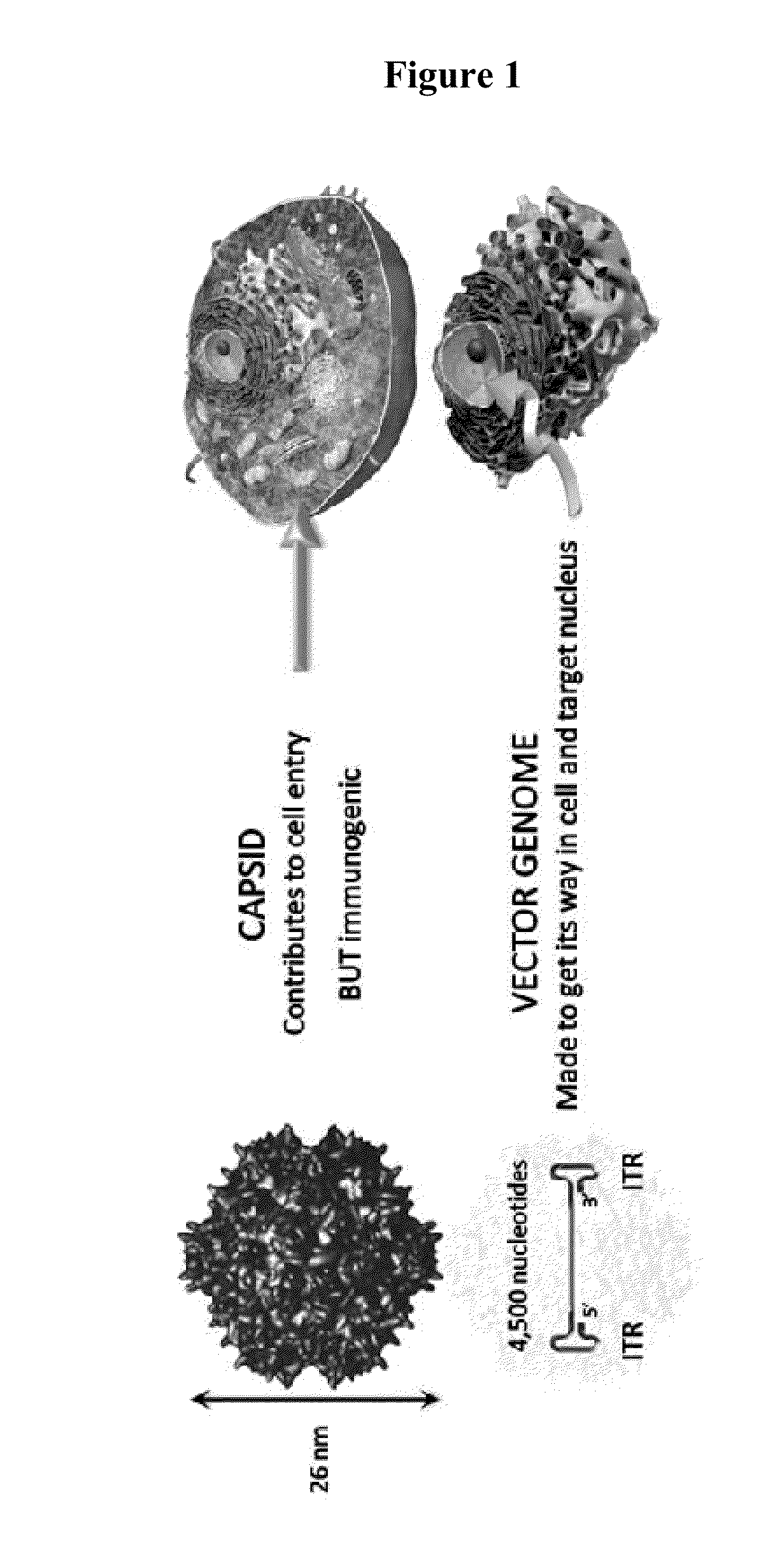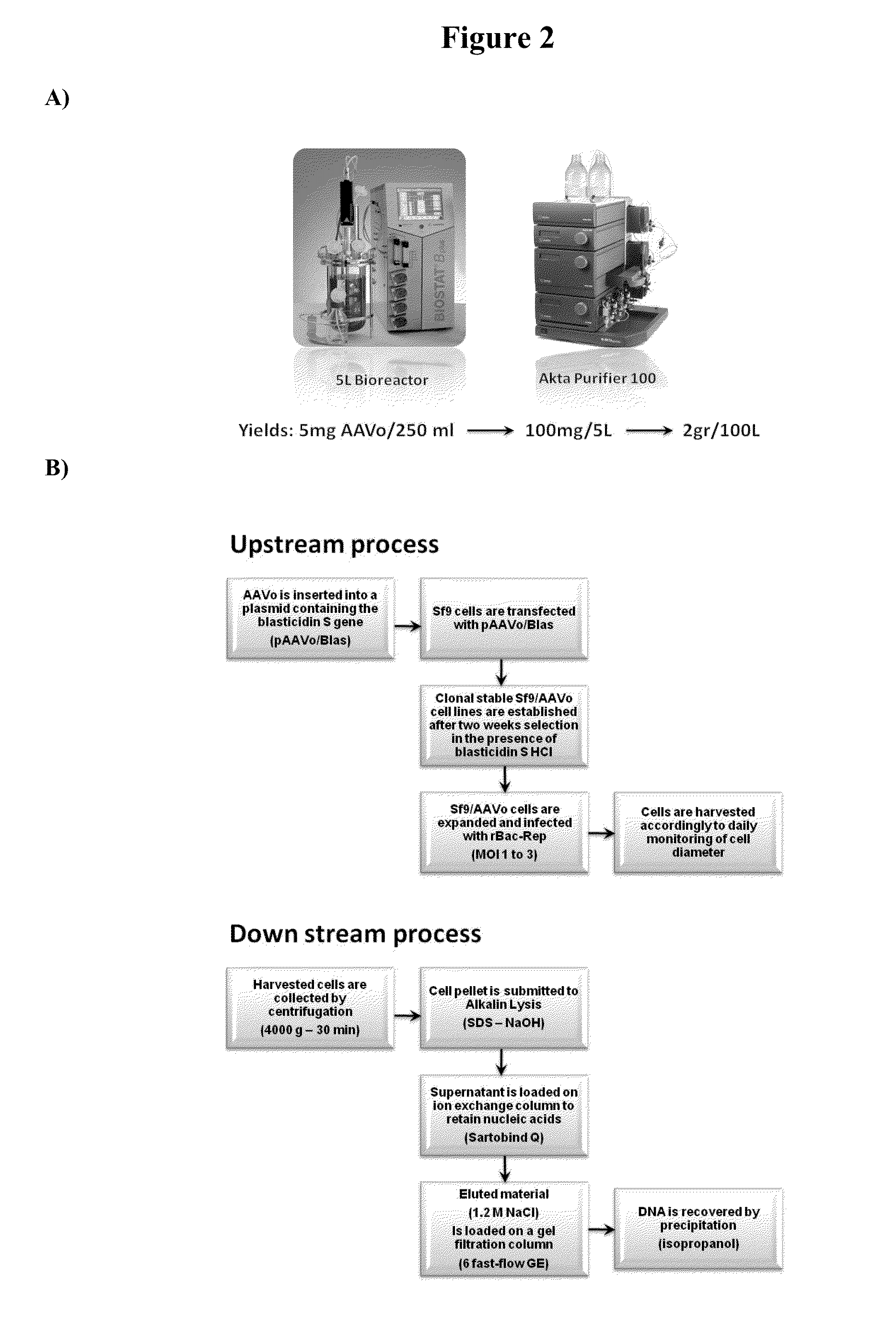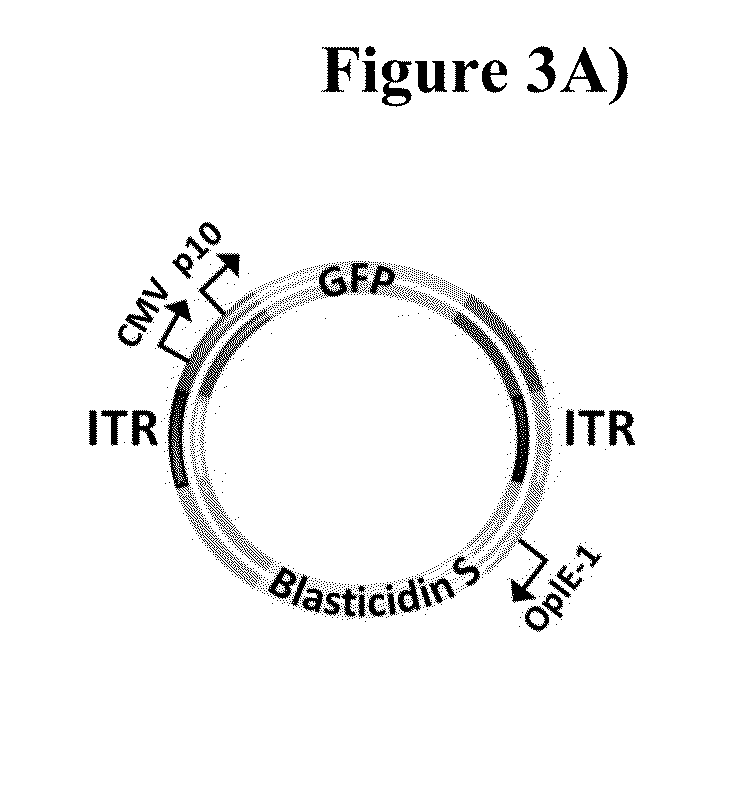Capsid-free aav vectors, compositions, and methods for vector production and gene delivery
a vector and vector technology, applied in the field of exogenous vector delivery, can solve the problems of low efficiency, limited viral packaging capacity of about 4.5 kb of heterologous dna, and elicit immune response of dystrophin
- Summary
- Abstract
- Description
- Claims
- Application Information
AI Technical Summary
Benefits of technology
Problems solved by technology
Method used
Image
Examples
example 1
Construction of rAAV0 Plasmids for rAAV0 Vector Production
[0143]The AAV0-GFP plasmid (“pFBGR / Blas”), was constructed as follows. The blasticidin S gene (2784-3183 bp) along with the Orgyia pseudotsugata immediate early-1 promoter (Op IE-1; 2401-2692 bp) (Invitrogen, Inc.) and EM7 promoter (2707-2765 bp) in pIB / V5-His / CAT plasmid (Invitrogen Inc.) was amplified by high fidelity PCR using primer sequences 5′-ATAAGCTTACGCTCAGTGGAAVGAAAAC-3′ (SEQ ID NO:7) and 5′-ATAAGCTTGACGTGTCAGTGTCAGTCCTGCTCCT-3′ (SEQ ID NO:8). After Hind III digestion, the 865 bp PCR product was cloned into the Hind III site of the AAV2 packaging plasmid, pFBGR (Urabe et al., 2002). Restriction mapping and DNA sequencing were carried out to confirm correct plasmid construction.
example 2
Production and Purification of rAAV0 Vectors
[0144]Clonal Sf9 cell lines were established for the pFBGR / Blas plasmid. Spodoptera frugiperda (Sf-9) cells were transfected with the pFBGR / Blas plasmid using Cellfectin (Invitrogen). Following transfections, cells were incubated for 3 days at 27° C. in insect cell culture medium (HyClone Inc.). Blasticidin S HCl (50 μg / ml) was then added to select for stable transformants. After a two-week selection period, dilution cloning and direct colony transfer techniques were used to obtain independent clonal cell lines. Transformed cells were cultured and expanded in 10% FBS HyQ growth medium to form distinct colonies under Blasticidin S HCl selection (10 μg / ml).
[0145]Blasticidin-resistant clonal cell lines were individually infected with recombinant baculovirus expressing AAV Rep 78 and Rep 52 (“Rep-Bac”) proteins (MOI=5) and screened for GFP expression. The Rep-Bac was as described in Urabe et al., 2002. The recombinant baculovirus was produced ...
example 3
rAAV0 Vector-Mediated Gene Expression in Vitro
[0147]Microinjection of rAAV0-GFP vector into nuclei or cytoplasm of 293 cells and C2C12 cells was carried out using a Xenoworks microinjection system (Sutter Instruments). Tetramethylrhodamine 70,000 MW lysine-fixable dextran was co-microinjected as an area marker of microinjection. Nuclei were stained with DAPI.
[0148]Furthermore, in order to demonstrate additional properties of rAAV0 compared to regular plasmid-DNA, the ability of rAAV0 to transduce cells when microinjected into the cytoplasm was tested. Indeed, plasmid-DNA needs to be delivered directly into the nucleus and cytoplasmic microinjections are not effective. Here, C2C12 myoblasts were grown and differentiated for 2 days. Microinjections of a solution (0.02 mg / ml) of AAV0-GFP vector into nuclei or cytoplasm of C2C12 myotubes were carried out using a Xenoworks microinjection system (Sutter Instruments). Tetramethylrhodamine 70,000 MW lysine-fixable dextran (Sigma) was also c...
PUM
| Property | Measurement | Unit |
|---|---|---|
| Immunogenicity | aaaaa | aaaaa |
Abstract
Description
Claims
Application Information
 Login to View More
Login to View More - R&D
- Intellectual Property
- Life Sciences
- Materials
- Tech Scout
- Unparalleled Data Quality
- Higher Quality Content
- 60% Fewer Hallucinations
Browse by: Latest US Patents, China's latest patents, Technical Efficacy Thesaurus, Application Domain, Technology Topic, Popular Technical Reports.
© 2025 PatSnap. All rights reserved.Legal|Privacy policy|Modern Slavery Act Transparency Statement|Sitemap|About US| Contact US: help@patsnap.com



